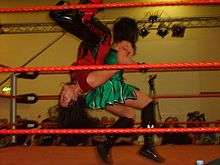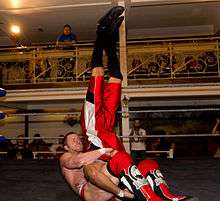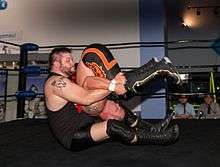Piledriver (professional wrestling)
.jpg)
A piledriver is a professional wrestling driver move in which the wrestler grabs his opponent, turns him upside-down, and drops into a sitting or kneeling position, driving the opponent head-first into the mat.[1] The technique is said to have been innovated by Wild Bill Longson.[2]
The name is taken from a piece of construction equipment, also called a pile driver, that drives countless massive impacts on the top of a large major foundation support, burying it in the ground slowly with each impact. The act of performing a piledriver is called "piledriving." Someone who has recently been the victim of a piledriver is said to have been "piledriven" (e.g. "The wrestler was piledriven into the canvas").
Notable wrestlers who have regularly used a piledriver during their career include Eric Young, Jerry Lawler, Bret Hart, Harley Race, Paul Orndorff, The Undertaker, Kane, The Brain Busters, Buddy Rogers, and Karl Gotch.
The piledriver is often seen as one of the most dangerous moves in wrestling. The reverse piledriver is directly responsible for shortening the career of Stone Cold Steve Austin when his opponent, Owen Hart, inadvertently botched the move, legitimately breaking Austin's neck. Due to this, the move is banned in the WWE with the exception of Kane and The Undertaker due to their experience and size.
Danger and precautions

The piledriver is generally considered a dangerous maneuver in wrestling because of the potential impact on the head and compression of the neck. The proper way to execute the move, in most cases, is for the wrestler performing the move to tuck the opponent's head between his legs before falling to the mat (there are variations that are performed differently, as the list below indicates). If done in this manner, the wrestler receiving the move will land with little or no contact made with the mat at all and thus not run the risk of injury.[4] If the head is not secured and is protruding from between the wrestler's legs, the wrestler receiving the move risks serious injury and potential paralysis as he will likely land with the entire weight of his body on the crown of his head.[5] Perhaps the most famous example of an injury from an improperly performed piledriver came at the 1997 WWF SummerSlam event. In a match between Owen Hart and Stone Cold Steve Austin, Hart was to perform a seated reverse piledriver on Austin, who later said that he was not sure if the move was a good idea to perform as he was unsure if his head could properly be protected. As Austin had feared, Hart botched the move and dropped Austin on top of his head. The impact jammed Austin's neck and left him temporarily paralyzed. He continued and finished the match, but stayed away from the ring for two months to recover from the injury. The physical demands of Austin's standing as one of the top stars in the WWF did not allow much downtime for him to rest and take care of the injury and as his career progressed, the damage got worse. Austin underwent surgery on the neck in 1999, but it never fully healed. By 2002, Austin's doctors told him that he risked permanent disability if he did not retire, and he finally did so in April 2003.[6]
The piledriver was banned in WWE in 2000, unless the wrestler has special permission to use the move.[5] In a discussion in 2007, Stephanie McMahon said that only two wrestlers were allowed to use the move, "two of the stronger guys", Undertaker and Kane.[7] In fact, The Undertaker's tombstone piledriver continues to be his finishing move.[8] The piledriver is also banned in many other promotions and certain cities. It is also considered an automatic disqualification in professional wrestling matches held in Tennessee, as the move is banned in that state.[9] In some promotions in the United Kingdom, the move can result in not only a disqualification, but a fine.[10] In Mexico, the piledriver (called a martinete) is an automatic disqualification.
Because of the dangers of the piledriver, it is classed as a foul and is illegal in mixed martial arts under the Unified Rules of Mixed Martial Arts.[11]
Variations
Aided piledriver

Any double-team move in which one wrestler help another to perform a piledriver on an opponent by pushing down on the opponent’s foot for more impact. In a variation of the move, the second wrestler jumps off the turnbuckle while pushing the opponent’s feet downward for even more damage, this is well known as a spike piledriver (not to be confused with a one-man spike piledriver).
Argentine piledriver
The move is executed from an Argentine backbreaker rack (face up, with the neck and one leg cradled) position. The wrestler pushes the opponent forward while holding the opponent's leg with one arm, and the head with the other arm, and then sits down, driving the opponent head first down to the floor.
Back-to-belly piledriver
The wrestler bends forward or crouches in front of their opponent, grabs hold of the opponent around the legs and stands up, lifting the opponent upside down facing the wrestler's back. The wrestler then either sits down or drops onto his knees, driving the opponent's head down to the mat.
A variation on this which is sometimes known as the sunset driver sees the attacking wrestler hook the opponent's legs underneath his/her arms while holding the opponent up in the back to belly position. From here, the wrestler drops to his / her knees, driving the opponent's head into the mat. This move will often see the attacking wrestler hold the move after landing for a rana style pinfall attempt.
Over-the-shoulder back-to-belly piledriver
This move begins with the wrestler facing his opponent. From there, the wrestler will pick up the opponent and place them over his / her shoulder so that the opponent's head is dangling over the wrestler's back by the waist of the wrestler. The wrestler then holds the opponent in place by holding his / her leg with one arm and applies a headlock to the opponent with his / her other arm. The opponent is now bent into a circle. The wrestler then drops to a seated position, driving the head and upper back of the opponent into the ground. This move was innovated by Mariko Yoshida, and dubbed the move the name Air Raid Crash, and was popularized by Fit Finlay, who dubbed it the Celtic Cross, CIMA, who uses it as the Schwein and Sheamus who dubs the move White Noise.
Belly-to-back piledriver
Also known as a Texas, or traditional piledriver, this is the classic and original piledriver technique. From a position in which the opponent is bent forward against the wrestler's midsection, the wrestler grabs around his / her opponent's midsection and lifts so that the opponent is held upside down facing in the same direction as the wrestler, the wrestler then drops to a sitting position with the opponent's head falling between the wrestler's thighs down to the mat.
Cradle piledriver
The cradle piledriver is a variation on standard piledrivers which sees the attacking wrestler grapevine the opponents leg with their arm. The most common of which is similar to a Texas piledriver. This move sees the attacking wrestler, from a position in which the opponent is bent forward against the wrestler's midsection, reach around the opponent's midsection and lifting them so that they are held upside down facing in the same direction as the wrestler, the wrestler then hooks his / her arms around one leg of the opponent before dropping to a sitting or kneeling position with the opponent's head falling between the wrestler's thighs down to the mat. It was a common finisher move for Minoru Suzuki, known as the Gotch-Style Piledriver.
This variant can be used on other types of piledriver; including the cradle tombstone piledriver variation, instead of wrapping both of his arms around the waist of the opponent, the wrestler wraps one arm around the waist and places his other arm between the opponent's legs, grabbing hold of his other arm. The wrestler then drops down on his knees, driving the opponent down to the mat head first.
Cross-arm piledriver
From a position in which the opponent is bent forward against the wrestler's midsection, the attacking wrestler crosses the arms of this opponent between their legs (a double pumphandle) before then lifting the opponent up into a vertical position and driving them down between the attacking wrestler's legs.
Double underhook piledriver

Also known as the Tiger Driver '98. In this piledriver, a wrestler will bend his opponent forward, placing the opponent's head between the wrestler's legs (a standing head scissors), and hooks each of the opponent's arms behind the opponent's back. He then pulls back on the opponent's arms lifting him/her up so that the opponent is held upside down facing in the same direction as the wrestler, the wrestler then drops to a sitting or kneeling position dropping the opponent's head into the mat.
Double underhook back-to-back piledriver
Also known as the vertebreaker, this move is executed from a position in which the opponent is standing behind the wrestler, the wrestler underhooks his/her arms under the opponent's arms. Then the wrestler twists his / her body around so that the wrestler is facing the ground and the opponent is standing with his / her back resting against the wrestler's back. Then the wrestler stands while the opponent is in an upside down position while both the opponent and the wrestler's arms are still hooked. The wrestler then drops to a sitting position. Another way to get the opponent into the position is to approach a standing opponent from behind, hook the opponent's arms, bend forward under the opponent, and then rise up, raising the opponent upside down.[12]
This technique is extremely dangerous, possibly one of the most dangerous maneuvers in professional wrestling, as the opponent's arms are restrained and their head is not placed between the wrestler's legs, giving them little to post against. The move was banned by WWE in April 2003, except for in cases where the wrestler received special permission to use the move.[13]
The move was innovated by Megumi Kudo, dubbing it the Kudo Driver. It is also used by Homicide who called it "Da Cop Killa" when in the independent circuit, and "Da Gringo Killa" in TNA. It was most famously used by Gregory Helms who called the move the Vertebreaker
Flip piledriver

The move, made famous by Petey Williams is also referred to as the Canadian Destroyer, or a sunset flip piledriver, begins in a position in which the opponent is bent forward against the wrestler's midsection, the wrestler grabs around his / her opponent's midsection latching onto the opponent's back, with his / her head to one side of the opponent's hips or between their legs, keeping his / her legs around the opponent's head. From this position the wrestler pushes off the mat with his / her legs to flip the opponent over.
As both wrestlers flip, the attacking wrestler uses his / her body weight to land in a seated position driving the opponent's head down to the mat between the wrestler's thighs. A double underhook variation exists in which the arms of a bent over opponent are placed in a butterfly prior to performing the flip.
Jumping piledriver
Also known as a spike piledriver, stuff piledriver or a belly-to-back piledriver, from a position in which the opponent is bent forward against the wrestler's midsection, the wrestler grabs around their opponent's midsection and lifts so that the opponent is held upside down facing in the same direction as the wrestler, the wrestler then jumps in the air and drops to a sitting position.
Kneeling piledriver
A variation of the piledriver where instead of dropping to a sitting position as in the basic piledriver, the wrestler drops to a kneeling position.
Kneeling reverse piledriver
Often referred to as a Tombstone Piledriver. A wrestler first stands facing an opponent and places their stronger arm between the opponent's legs and their weaker arm on the opponent's opposite shoulder. They then lift the opponent onto their stronger shoulder, turning them upside-down similar to a scoop slam lift. The opponent is then lowered while being held so that the opponent's head is hanging between the standing wrestler's knees. The wrestler then falls or jumps to his knees, driving the opponent's head into the mat. Famously, this move was popularized by The Undertaker as his "Deadman" finisher, and its name is related to his gimmick. It is often also used by his kayfabe brother Kane.
Package piledriver

A package piledriver is almost the same as a basic piledriver, but instead of grabbing the waist of the opponent, the wrestler puts their arms underneath the opponent's arms and grabs their legs by the knees. The wrestler then stands up, lifting the opponent until they are upside down, and drops to a sitting position with the opponent's head between their thighs.
There is also an inverted version of the move in which an attacking wrestler reaches between an opponent's legs with one arm and reaches around that opponent's back from the same side with his other arm before lifting their opponent upside down into a belly-to-belly position. The attacker then grabs the opponent's legs by the knees, jumps up, then drops to a sitting position with the opponent's head between their thighs.
This move was popularized by Kevin Steen during his time on the independent circuit.
Pulling piledriver
Also known as a stump piledriver. This is a variation of the Texas piledriver where, instead of wrapping their arms around the opponent's waist, a wrestler grabs onto the back of the waistband of an opponent's tights to lift them upside down before dropping into a sitting position.
Reverse piledriver
A wrestler faces an opponent and grabs the opponent's waist and turns them upside-down, holding them belly-to-belly against their torso. The wrestler then jumps up and drops down to a seated position, driving the opponent's head down to the mat between the wrestler's thighs.
Pumphandle reverse piledriver
This variation sees an attacking wrestler first lock an opponent in the pumphandle hold before then using the hold to raise the opponent up over the shoulder of the attacking wrestler. From here the attacking wrestler brings the opponent down into the belly-to-belly position before then sitting down for a reverse piledriver with the opponent's head impacting the mat between the legs of the attacking wrestler. This move was used as a finisher by Tony Nese.
Scoop side piledriver
Facing his opponent, the wrestler reaches between their opponent's legs with their right arm and reaches around the opponent's neck from the same side with their left arm. They then lift the opponent up on their chest so that they are facing downwards. The wrestler then moves their left arm from around the opponent's neck to around the opponent's torso. They then turn the opponent so that they are upside down on one side of the wrestler. The wrestler then jumps up and falls down to a sitting position, driving the opponent down to the mat neck and shoulder first.
Scoop slam piledriver
Facing their opponent, the wrestler reaches between his opponent's legs with their right arm and reaches around the opponent's neck from the same side with their left arm. They then lift the opponent up and turn them around so that they are held upside down, as in a scoop slam. The wrestler then drops down to their knees, driving the opponent down to the mat neck and shoulder first. There is also a seated version of this move.
Vertical suplex piledriver
The wrestler applies a front facelock to the opponent and hooks the opponent's near arm over their shoulder and lifts them into a vertical suplex position. They then turn the opponent 180°, force the opponent into the reverse piledriver position, then drop to a sitting position, dropping the opponent on their head. This move was innovated by Scott Steiner, who called it Steiner Screwdriver. It s also used by Brian Cage who calls it the Drill Claw.
Wheelbarrow piledriver
Similar to a wheelbarrow facebuster but instead of dropping their opponent face first, they drop their opponent so that the opponent lands on their upper back and neck between the legs of the wrestler, facing towards them usually resulting in a pin.
See also
References
| Wikimedia Commons has media related to Piledrivers. |
- ↑ "234-pound wrestler injures Andy Kaufman in grudge fight". St. Petersburg Times. Retrieved 2009-11-24.
- ↑ Luce, Don. "Bill Longson". PWHF.com. Professional Wrestling Hall of Fame and Museum. Retrieved 28 December 2013.
- ↑ "ROH news: B.J. Whitmer injured receiving a piledriver at Saturday's show; Sources - ROH star signs long-term deal". Pro Wrestling Torch. Retrieved 16 March 2014.
- ↑ Hollywood Hulk Hogan, Terry Bolea's autobiography, pg 202. Simon and Schuster. ISBN 0-7434-7556-9.
- 1 2 Powell, John (July 20, 2000). "Piledriver ban handicaps everyone". SLAM! Wrestling. Retrieved 2009-11-24.
- ↑ Steve Austin - a biography of wrestling superstar "Stone Cold" Steve Austin Eric Cohen, About.com Guide
- ↑ "Committee on Oversight and Government Reform interview of Stephanie McMahon" (PDF). p. 120. Archived from the original (PDF) on 2011-05-06. Retrieved 2011-09-27.
- ↑ "Amazing But True..". WWE Magazine (16): 13. October 2007.
- ↑ Andy Kaufman vs. Jerry Lawler Eric Cohen, About.com Guide
- ↑ Frontier Wrestling Alliance#Rules
- ↑ "Archived copy". Archived from the original on 2012-07-05. Retrieved 2011-05-17.
- ↑ "What a manoeuvre! 15 moves that really exist". WWE. 2012-11-30. Retrieved 2014-03-13.
- ↑ Madigan, TJ (April 5, 2003). "Forget me not". SLAM! Wrestling. Retrieved 2009-11-24.